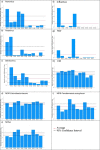Influence of public health and infection control interventions during the severe acute respiratory syndrome coronavirus 2 pandemic on the in-hospital epidemiology of pathogens: in hospital versus community circulating pathogens
- PMID: 36369056
- PMCID: PMC9651880
- DOI: 10.1186/s13756-022-01182-z
Influence of public health and infection control interventions during the severe acute respiratory syndrome coronavirus 2 pandemic on the in-hospital epidemiology of pathogens: in hospital versus community circulating pathogens
Abstract
Background: The first detection of severe acute respiratory syndrome coronavirus 2 (SARS-CoV-2) in Germany was reported in early February 2020. In addition, extensive control measures on the coronavirus disease 2019 (COVID-19) pandemic have been placed in Germany since March 2020. These include contact and travel restrictions, distance rules, mandatory wearing of face masks and respirators, cancellation of mass events, closures of day-care centers, schools, restaurants and shops, isolation measures, and intensified infection control measures in medical and long-term care facilities. Changes in demand or access to health care services and intensified control measures can lead to changes in transmission dynamics and imply effects on the overall occurrence of infectious diseases in hospitals.
Methods: To analyze the impact of infection control measures implemented in public on infectious diseases in hospitals, surveillance data from Marburg University Hospital were analyzed retrospectively. The analysis was conducted from January 2019 to June 2021, referred to hospital occupancy and mobility data in the county of Marburg-Biedenkopf, and correlated to control measures in hospitals and the general population.
Results: The COVID-19 pandemic and associated measures immediately impacted the occurrence of infectious diseases at the Marburg University Hospital. Significant changes were detected for virus-associated respiratory and gastrointestinal diseases. The massive drop in norovirus infections was significantly affected by the onset of the pandemic (P = 0.028). Similar effects were observed for rotavirus (up to - 89%), respiratory syncytial virus (up to - 98%), and adenovirus infections (up to - 90%). The decrease in gastrointestinal and respiratory virus detection rates was significantly affected by the decline in mobility (P < 0.05). Of note, since April 2020, there have been no detected influenza cases. Furthermore, Clostridioides difficile-related infections declined after late 2020 (- 44%). In contrast, no significant changes were detected in the prevalence of susceptible and drug-resistant bacterial pathogens. In particular, the detection rates of methicillin-resistant Staphylococcus aureus isolates or multidrug resistant (MDR) and extended drug resistant (XDR) bacteria remained constant, although the consumption of hand disinfectants and protective equipment increased.
Conclusions: The COVID-19 pandemic and associated public health measures had a significant impact on infectious diseases and the detection of pathogens at the Marburg University Hospital. Significant changes were observed for community transmissible infections, while no such effects on pathogens primarily associated with nosocomial transmission could be detected.
© 2022. The Author(s).
Conflict of interest statement
The authors declare that they have no competing interests.
Figures


Similar articles
-
Collateral impacts of pandemic COVID-19 drive the nosocomial spread of antibiotic resistance: A modelling study.PLoS Med. 2023 Jun 5;20(6):e1004240. doi: 10.1371/journal.pmed.1004240. eCollection 2023 Jun. PLoS Med. 2023. PMID: 37276186 Free PMC article.
-
Protective effect of SARS-CoV-2 preventive measures against ESKAPE and Escherichia coli infections.Eur J Clin Invest. 2021 Dec;51(12):e13687. doi: 10.1111/eci.13687. Epub 2021 Oct 11. Eur J Clin Invest. 2021. PMID: 34599600 Free PMC article.
-
The impact of the COVID-19 pandemic on hospital-acquired infections at a comprehensive cancer center.Am J Infect Control. 2023 Dec;51(12):1302-1308. doi: 10.1016/j.ajic.2023.08.019. Epub 2023 Oct 5. Am J Infect Control. 2023. PMID: 37804272
-
Lifting non-pharmaceutical interventions following the COVID-19 pandemic - the quiet before the storm?Expert Rev Vaccines. 2022 Nov;21(11):1541-1553. doi: 10.1080/14760584.2022.2117693. Epub 2022 Sep 5. Expert Rev Vaccines. 2022. PMID: 36039786 Review.
-
Infection Prevention Precautions for Routine Anesthesia Care During the SARS-CoV-2 Pandemic.Anesth Analg. 2020 Nov;131(5):1342-1354. doi: 10.1213/ANE.0000000000005169. Anesth Analg. 2020. PMID: 33079853 Review.
Cited by
-
Technologies and therapeutics for ongoing prevention of respiratory infections.Clin Transl Immunology. 2023 Feb 27;12(2):e1442. doi: 10.1002/cti2.1442. eCollection 2023. Clin Transl Immunology. 2023. PMID: 36861031 Free PMC article. No abstract available.
-
Detection of hospital environmental contamination during SARS-CoV-2 Omicron predominance using a highly sensitive air sampling device.Front Public Health. 2023 Jan 10;10:1067575. doi: 10.3389/fpubh.2022.1067575. eCollection 2022. Front Public Health. 2023. PMID: 36703815 Free PMC article.
-
Molecular evolutionary analysis of novel NSP4 mono-reassortant G1P[8]-E2 rotavirus strains that caused a discontinuous epidemic in Japan in 2015 and 2018.Front Microbiol. 2024 Jul 10;15:1430557. doi: 10.3389/fmicb.2024.1430557. eCollection 2024. Front Microbiol. 2024. PMID: 39050631 Free PMC article.
-
Bacillaceae serine proteases and Streptomyces epsilon-poly-L-lysine synergistically inactivate Caliciviridae by inhibiting RNA genome release.Sci Rep. 2024 Jul 2;14(1):15181. doi: 10.1038/s41598-024-65963-9. Sci Rep. 2024. PMID: 38956295 Free PMC article.
References
Publication types
MeSH terms
LinkOut - more resources
Full Text Sources
Medical
Miscellaneous

